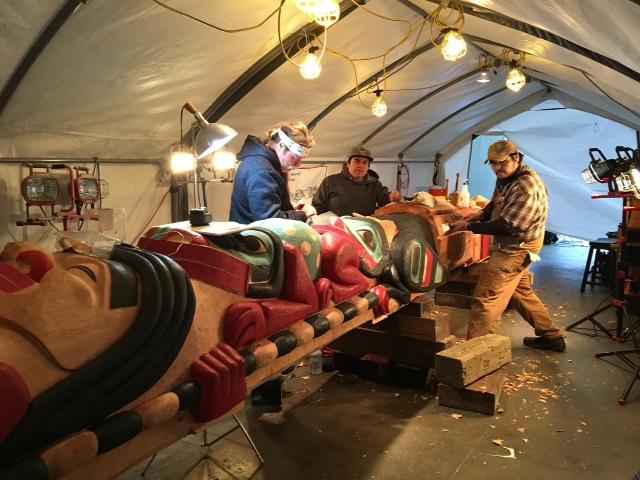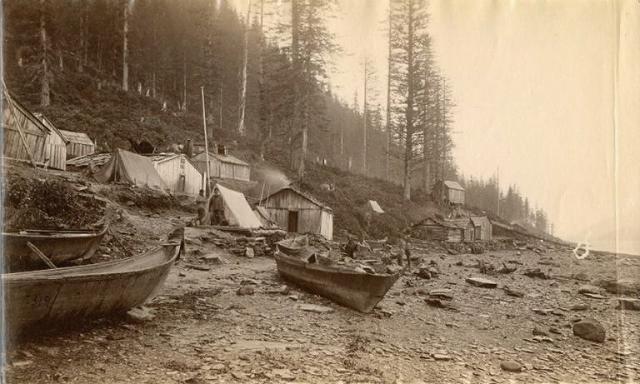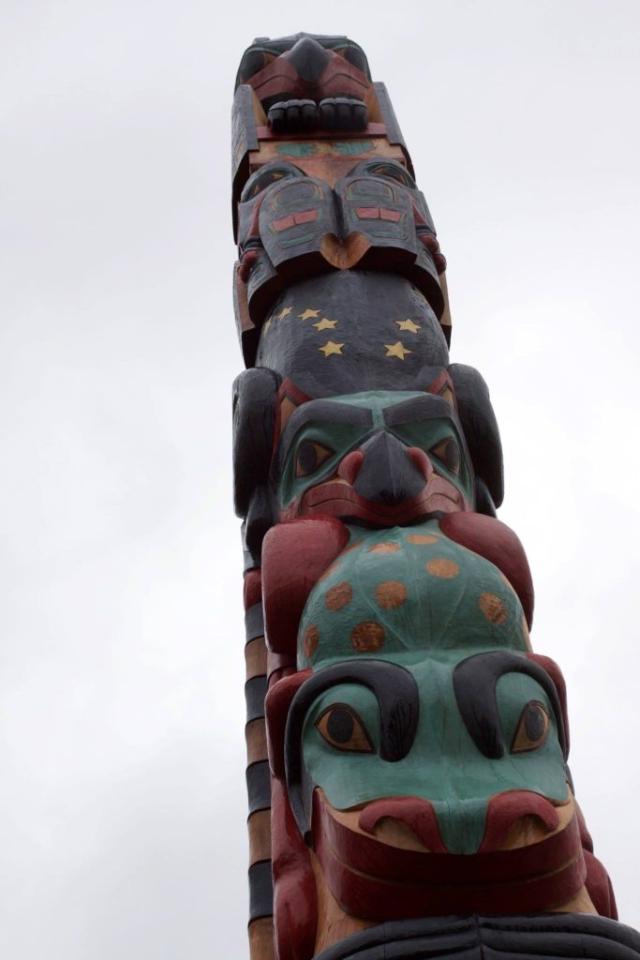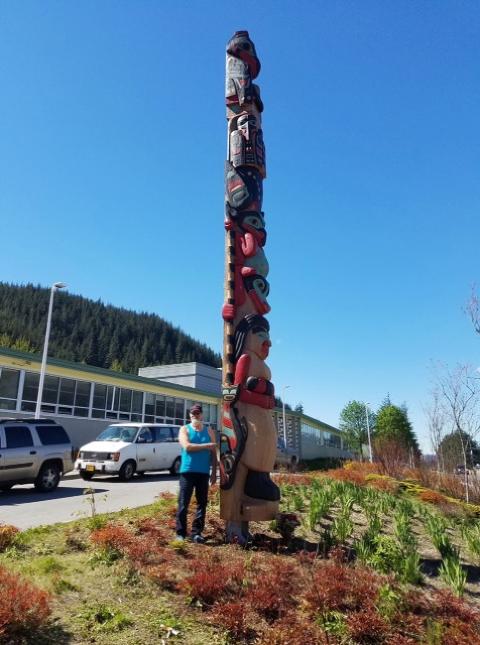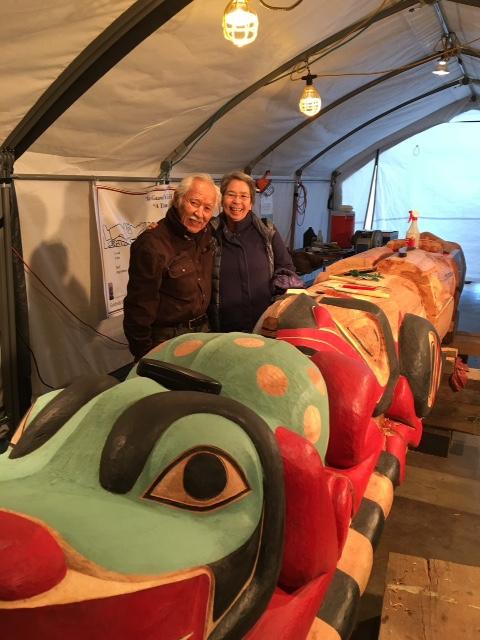 |
Canku Ota
|
 |
|
(Many Paths)
|
||
|
An Online Newsletter
Celebrating Native America
|
||
|
July 2017 - Volume 15
Number 7
|
||
|
|
||
|
The Music of Totem
Poles
|
||
|
by Frank Hopper - Indian
Country Today
|
||
|
Tlingit totem
pole honors ancestors whose graves were bulldozed in 1956
He'd just filled a truck with dirt in front of Juneau's Gastineau Elementary School in June 2012 and was checking the hole before sending the truck away when something caught contractor Jim Mason's eye. It was round and smooth. Mason jumped out of the excavator for a closer look. As he approached, he recognized what it was. It was a human skull. Renovation Reveals a Forgotten Native Cemetery In 1956, the City of Douglas, Alaska, which was later absorbed into the City of and Borough of Juneau, wanted to build an elementary school near the old Douglas Indian Cemetery. No one knew the exact boundaries of the original cemetery, where members of the Raven clans of the T'aaku Kwáan, a village of Tlingit Indians, had been buried since the old mining days of the 1880s. The current cemetery covers less than a quarter acre and contains only a few graves, but Native elders knew there were more outside that area. Some had been moved when the Douglas Highway was put in, some were just covered over. City officials knew there were unmarked Native graves in the area, but didn't seem to care. In 1937 a fire destroyed all records of the graves, so the city fathers felt free to bulldoze over and build Gastineau Elementary right on top of them. After all, the graves were just Indians who had lived in shacks by the water, laborers who sometimes worked in the local mines. To city leaders, the graves were useless Native residue left over from the gold rush days. Nearly 60 years later, those hidden graves allowed themselves to be discovered by a fellow Tlingit.
Discovery of Native Graves Opens Old Wounds "We dug and saw some debris. We weren't sure what it was at first. Then we realized it was the skull of a human and we shut the process down," Jim Mason recently told ICMN. Mason, a Tlingit of the Raven Sockeye clan originally from Haines, recalls finding the remains as he and his company, Glacier State Contractors, helped renovate Gastineau Elementary in the summer of 2012. He described finding caskets and bones and even little artifacts. "They had their stuff in their caskets to travel with them on their journey. It was really cool. There were tea cups, there were plates, there was a little provision for the tea still in the cup. One guy had his six-shooter in there." Mason says they called the City and Borough of Juneau (CBJ), who sent someone out to shut the site down and begin researching the graves. State officials were called, as was the Douglas Indian Association, the modern name of the T'aaku Kwáan. For years the DIA tried to get the CBJ to investigate the true size of the cemetery, but nothing was ever done. Now bodies were spilling out.
Discovery Sparks
Grief Process to Resume The possessions found with the graves showed one important thing: these people were loved. Relatives carefully buried them along with items that might comfort them on their journey. DIA tribal administrator Andrea Cadiente-Laiti remembers the tribe's reaction when they received news of the discovery: "It was a very difficult time for us, in that one of the things that we came to grips with was that we had to transcend the anger of generations," she said at a special blessing ceremony held at the grave sites a month after they were discovered, as reported by the Juneau Empire. In fact, this isn't the first Native cemetery in the area to be desecrated. It Happened Once Before Another Tlingit cemetery just across Gastineau Channel in Juneau was desecrated and built-over in 1914. In her 2006 memoir, Blonde Indian (University of Arizona Press), Alaska State Writer Laureate Ernestine Hayes relates how homes were built over the original Juneau Cemetery and Native graves were just dumped out on a hillside along with the excavated dirt. A government official at the time quoted an unnamed Tlingit woman whose poignant description of the desecration could also apply today: "White men crowd Natives out from the land on which their very homes stand. Will they not even allow our dead to have a resting place?"
A Plan for Two Totem Poles To open a path for healing, the Native-owned Goldbelt Heritage Foundation received a federal grant to fund "A Time for Healing – Ganéix Gaawú Kudzitee" a project to create two memorial totem poles, the first a Raven Pole to honor the ancestors whose graves were desecrated, which was raised on May 13 in front of Gastineau Elementary School. The second will be an Eagle Pole to promote healing from a 1962 incident in which the City of Douglas burned down the Douglas Indian Village to make way for a boat harbor and a park. The families who lived there were permanently displaced and received little or no compensation. The Eagle Pole is scheduled to be carved next year. Famed Tlingit totem pole artist and master carver Nathan Jackson designed the Raven Pole to honor the Ghaanxh.ádi, Ishkeetaan, and Kookhittaan clans of the T'aaku Kwáan all of which are of the Raven moiety. The planned Eagle Pole will honor the Yanyeidí, Tookhu.eidí, S'eetkhweidí and Tsaateeneidí clans of the Eagle/Wolf moiety. Together, the Raven and Eagle poles will honor all the clans of the T'aaku Kwáan and will memorialize the ancestors and relatives who suffered the callous racism of the old Douglas city government. Lead carver Mick Beasley took Jackson's design and applied it to a 26-foot red cedar log donated by the Alaska Native Corporation Sealaska. He supervised a crew of four carvers, mentor carver Fred Fulmer and apprentice carvers Herb Sheakley, Jeffrey Isturis and Elijah Marks.
The Music of Totem Poles In a powerfully moving video recorded at the Sealaska Heritage Institute Walter Soboleff Building the evening of the Raven Pole raising, Lyle James of the Goldbelt Heritage Foundation honors the carvers for creating the pole, which he calls grandpa: "It's the handiwork of these men who stand before us and other men who weren't able to make it here this evening. It's because of them that we get to see our grandpa standing proud. It's because of them that we get to hear our stories for generations to come. It's because of them… we're going to make them damn proud tonight!" James invites those assembled to dance and sing an ancient clan song. Families dance wearing precious regalia as drums beat, heads shake and bodies whirl. Mentor carver Fred Fulmer Sr., an Eagle of the Chookaneidi, Iceberg House, was inspired to carve by his great-grandfather, master carver Frank Sinclair Sr. and was first taught carving by his clan uncle Ray Nielsen Sr. He spins and jumps as if the dance of his relatives were moving through him in a timeless ocean of past, present and future. To those present, the totem pole standing across the channel in Douglas also sang. But instead of musical tones, the song of the totem pole was expressed by many different actions, in particular the Tlingit eyes that found the graves, the Tlingit mind that designed the pole, the Tlingit hands that carved it, and the Tlingit hearts that remember the ancestors and now welcome them home. This is the music of culture, not just a set of designs and traditions, but instead a living thing that heals and strengthens. When the Tlingit of the T'aaku Kwáan look at the Raven Pole, this is the music they hear, the music of totem poles.
|
|||||||||||
|
|
|
|
||
|
|
||
| Canku Ota is a free Newsletter celebrating Native America, its traditions and accomplishments . We do not provide subscriber or visitor names to anyone. Some articles presented in Canku Ota may contain copyright material. We have received appropriate permissions for republishing any articles. Material appearing here is distributed without profit or monetary gain to those who have expressed an interest. This is in accordance with Title 17 U.S.C. Section 107. | ||
|
Canku Ota is a copyright ©
2000 - 2017 of Vicki Williams Barry and Paul Barry.
|
||
 |
 |
|
|
The "Canku
Ota - A Newsletter Celebrating Native America" web site and
its design is the
|
||
|
Copyright ©
1999 - 2017 of Paul C. Barry.
|
||
|
All Rights Reserved.
|
||
